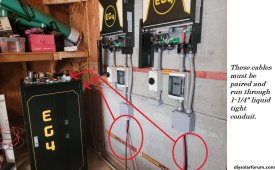timselectric
If I can do it, you can do it.
- Joined
- Feb 5, 2022
- Messages
- 18,851
DC is more dangerous than AC. (No zero point crossing)Hmm, not voltage? DC is safer to a higher voltage than AC.
current doesn't flow without enough voltage to push it.What about available current?
That is expected to be raised.Also the threshold for safe voltage level in rapid shutdown was set to 30V (and 240VA in some code iterations). Fixed 48V battery is way way above that.
Probably in the next code cycle. Due to panels getting larger. But not sure how much. Because RSD is to protect firefighters. And if they're up there, everything is going to also be wet.



